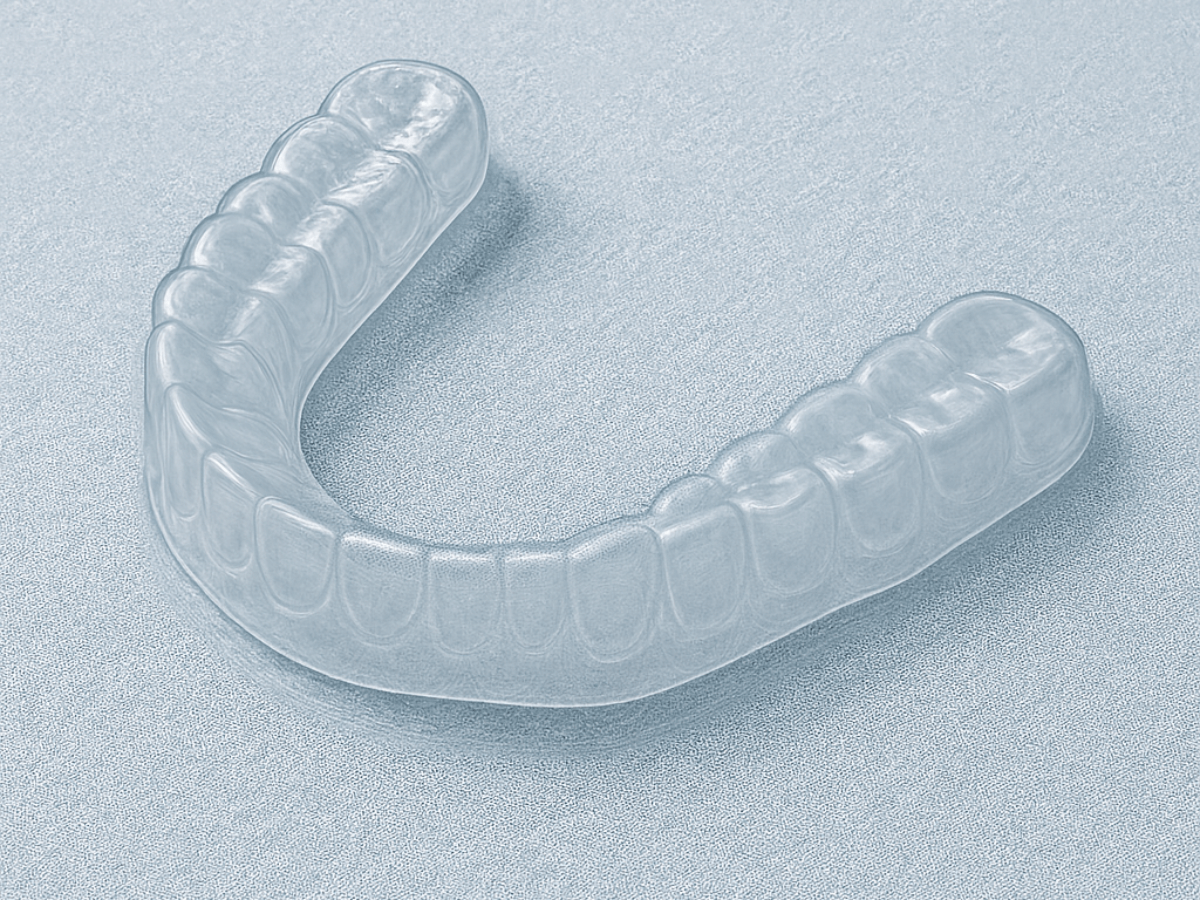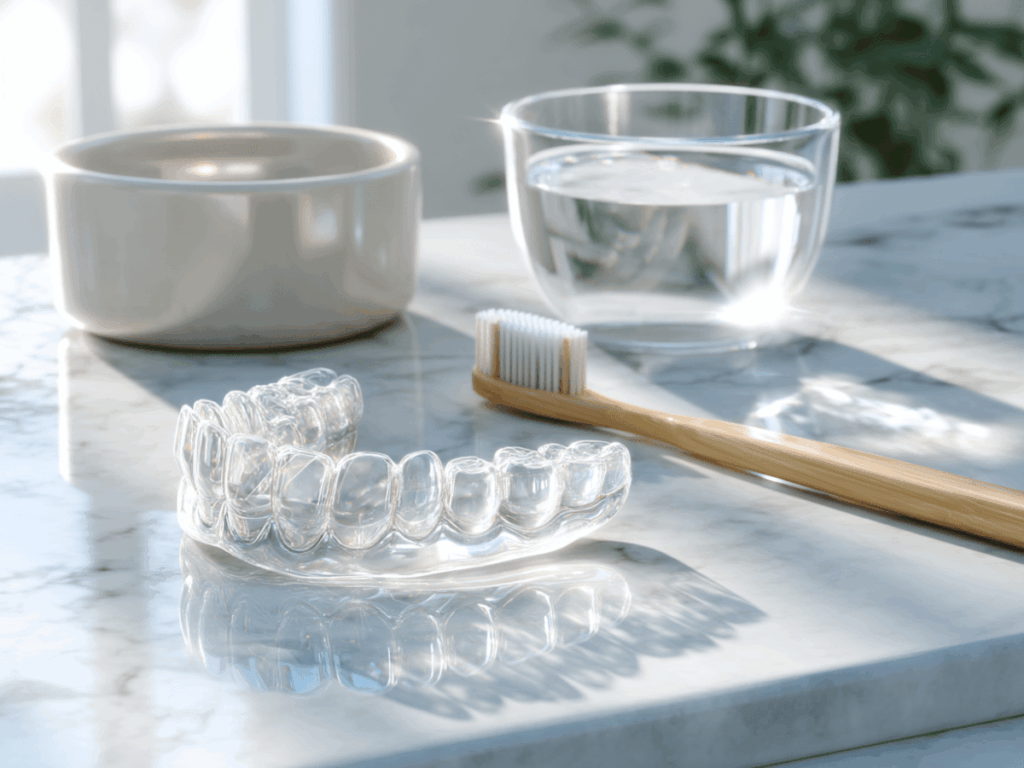Braces may be off, but your smile still needs backup. Clear, removable, or fixed retainers only work if you care for them properly. Skipping cleanings can lead to plaque buildup, bad breath, and even unwanted tooth movement. If you’re just finishing braces or Invisalign, it’s worth remembering that your retainer plays a key role in keeping everything in place just like choosing the right treatment did at the start.
At Elizabeth L. Wakim DDS, we help patients maintain healthy smiles well beyond braces. Our team provides clear guidance on cleaning routines, safe storage, and how to know when it’s time for a replacement. The goal is to keep your retainer and your smile in top condition for the long haul.
Let’s take a closer look at what makes a clean retainer routine simple and effective.
Understanding Your Retainer Type
A retainer isn’t a one-size-fits-all device, knowing yours helps you care for it effectively and protect your smile for the long haul.
Hawley Retainers (Wire and Acrylic)
The classic choice, Hawley retainers are made of a sturdy acrylic base worn on the palate, with a wire that wraps around your front teeth. They’re adjustable, making them ideal if your orthodontist needs to fine-tune fit over time. Research shows that patients using Hawley retainers tend to have better gum health.
These retainers are durable and long-lasting, but their visibility might not be ideal if you’re after discretion.
Clear Plastic Retainers (Essix or VFR)
Made from transparent plastic that molds snugly to your teeth, these retainers are nearly invisible. Essix retainers are often chosen for their discreet look and how comfortable they feel in daily wear.
However, they can be more fragile than Hawley retainers, especially if exposed to heat or harsh cleaning methods. They may also need to be replaced more frequently due to wear or discoloration.
Bonded (Fixed) Retainers
This type is permanently attached behind your front teeth using dental cement. Studies show that fixed retainers are effective for keeping teeth in place and supporting long-term oral health. They’re perfect for those who may forget to wear a retainer or who want a hassle-free option, there’s no daily removal required.
The downside? Cleaning around the wire can be tricky. You’ll need to be diligent with flossing or using a water flosser to prevent plaque buildup.
How to Tell Which One You Have
Not sure what kind of retainer you’re wearing? Here’s a quick way to find out:
- Can you take it out? If yes, it’s removable. If not, it’s likely a bonded (fixed) retainer.
- Is it clear and snug over your teeth? That’s most likely an Essix retainer.
- Does it have a visible wire and an acrylic base? You’re probably wearing a Hawley.
Understanding which type you have helps you stay on top of fit, comfort, and when it’s time to follow up with your orthodontist for adjustments or replacement. If you’re curious how your retainer fits into the bigger picture of your orthodontic journey, this breakdown of clear aligners vs. braces offers helpful insight.
How to Clean Your Retainer the Right Way
No matter what type of retainer you have, daily cleaning is non-negotiable. It prevents odor, plaque buildup, and unwanted bacteria from lingering in your mouth. But how you clean it depends on the type you wear.
For Hawley Retainers (Wire and Acrylic)

- Rinse after every use: Run it under lukewarm water immediately after removal to prevent dry buildup.
- Brush gently: Use a soft-bristled toothbrush and non-whitening toothpaste or mild dish soap. Be careful not to bend the wire.
- Deep clean weekly: Soak in a denture cleaner or a mix of equal parts white vinegar and water for 15–30 minutes. Rinse thoroughly before wearing.
- Avoid hot water: High heat can warp the acrylic base.
For Essix (Clear Plastic) Retainers

- Rinse before and after wearing: Saliva and dry plaque can cloud the plastic if not cleaned regularly.
- Use a non-abrasive cleaner: A gentle toothbrush with clear, alcohol-free dish soap works well. Avoid whitening toothpaste which can scratch the surface.
- Soak sparingly: Once or twice a week, use a retainer cleaner tablet or diluted vinegar solution. Rinse thoroughly before placing it back in your mouth.
- Keep it away from heat: Don’t use boiling water, leave it in a hot car, or soak it in mouthwash with alcohol. These can deform or discolor the plastic.
For Bonded (Fixed) Retainers

- Floss daily: Use floss threaders or a water flosser to clean between and around the wire.
- Brush thoroughly: Pay special attention to the gum line and the areas where the wire is bonded to your teeth.
- Schedule regular dental cleanings: Fixed retainers are prone to tartar buildup, especially on the back of the lower front teeth.
Cleaning Mistakes to Avoid
Even with the best intentions, some habits can do more harm than good. Here are the most common cleaning mistakes that could damage your retainer or your smile.
- Scrubbing with Whitening Toothpaste: Whitening pastes often contain abrasive particles that scratch retainers, especially Essix-style ones. Over time, those scratches can trap bacteria and lead to cloudiness or odor.
- Soaking in Alcohol-Based Mouthwash: Mouthwash with alcohol may seem like a good disinfectant, but it can dry out and weaken retainer materials. Opt for an alcohol-free solution or a designated retainer cleaner instead.
- Skipping the Daily Rinse: Letting saliva and plaque sit on your retainer all day can lead to odors, staining, and buildup. A quick rinse after each use keeps it fresh and bacteria-free.
- Leaving It Out Uncovered: When retainers dry out or get exposed to open air, bacteria can settle on the surface. Always store yours in a clean, ventilated case when not in use.
- Using Harsh Chemicals or Bleach: Bleach and other strong disinfectants may kill bacteria, but they also degrade the material and can be harmful to your mouth. Stick to safe, dentist-approved methods.
Signs Your Retainer Needs Attention or Replacement
Retainers play a crucial role in preserving your teeth alignment after orthodontic treatment, but they aren’t built to last forever. Even a well-maintained removable retainer or permanent retainer can wear down with time, impacting your comfort, oral hygiene, and results.
Not sure if yours is still doing its job? Here’s what to look for:
1. It Feels Loose or Too Tight
If your retainer inside suddenly feels like it’s pinching, slipping, or not fitting like it used to, it could mean your teeth are shifting. This change may signal that your retainer is no longer effective or that your teeth have already moved into new positions.
2. You Notice Cracks or Warping
Small cracks on the retainer’s surface can trap food particles and promote bacterial growth. Clear retainers and clear aligners are especially vulnerable to harmful substances, hot water, and pressure that can cause warping. Once the shape is compromised, your retainer can’t guide your teeth effectively.
3. There’s a Lingering Odor or Discoloration
If you’ve tried cleaning tablets, ultrasonic retainer cleaners, or soaking with baking soda and hydrogen peroxide, but you’re still noticing unpleasant odors or discoloration, the material may be breaking down. This is a high-risk indicator that it’s time for a replacement.
4. It Hurts or Irritates Your Gums
Pain, redness, or sores along the gum line may mean your retainer has sharp edges or no longer fits properly. This discomfort can lead to oral health issues like gum disease or tooth decay, especially if you’re wearing retainers for extended periods.
5. You Haven’t Replaced It in Years
Even with regular cleaning, gently scrubbing, and proper storage in a retainer case, most retainers have a shelf life. If yours is more than a few years old, ask your dental professional if it’s time to upgrade to a properly cared version especially if you’re still in a high risk phase for relapse.
Keep Your Smile on Track with Consistent Retainer Care
Retainers may be small, but they have a big job: preserving all the work put into your orthodontic treatment and keeping your smile healthy for the long haul. With the right care, daily cleaning, regular checkups, and attention to early wear, you can extend the life of your retainer and avoid setbacks like tooth decay, gum disease, and shifting teeth. A thorough bite analysis and joint assessment can also reveal hidden issues affecting how well your retainer fits and functions over time.
If your retainer has started to feel off, show signs of damage, or hasn’t been evaluated in years, it may be time for an update. Don’t wait until discomfort or alignment changes creep in.
Our team is here to help you protect your results with personalized care. Whether you need guidance on cleaning, storage, or replacement, we’re happy to walk you through your options. Contact our Pennsylvania office at (724) 558-8222 or use our contact form to schedule a visit. Let’s keep your smile and your retainer working beautifully together.

